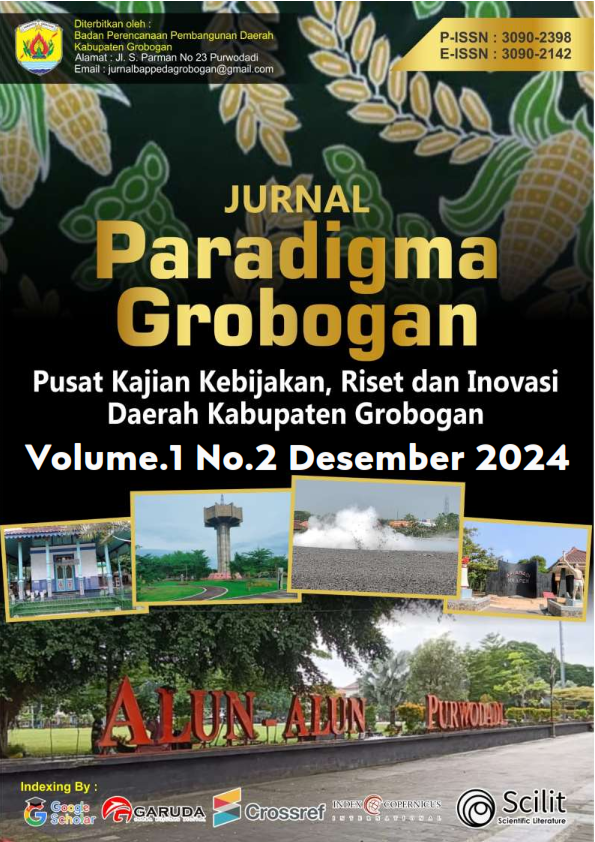Analisis Sektor Unggulan Kabupaten Grobogan Menggunakan Metode LQ, DLQ, dan Tipologi Klassen Periode 2020-2024
DOI:
https://doi.org/10.58684/paradigma.v2i1.47Keywords:
Location Quotient, Dynamic Location Quotient, Klassen Typology, Key Sectors, Grobogan Economic GrowthAbstract
Local governments have the authority to manage local resources to promote economic growth as a consequence of regional autonomy. To establish effective development policies, it is important for local governments to comprehensively map the potential of key economic sectors. The objective of this study is to identify the key economic sectors in Grobogan Regency, which includes 17 different sectors. This analysis was conducted using Gross Regional Domestic Product (GRDP) data at constant prices for the period from 2020 to 2024. Using a descriptive quantitative approach, this study employs three main analytical methods: Location Quotient (LQ) to identify core sectors, Dynamic Location Quotient (DLQ) to analyse sector growth prospects, and Klassen Typology to classify sectors based on growth and contribution. The analysis results show that the LQ identifies 10 sectors as core sectors in Grobogan Regency, with agriculture, forestry, and fisheries being the most prominent. In-depth DLQ analysis identified seven sectors with significant growth potential, with manufacturing emerging as the most promising. Meanwhile, Klassen Typology classified agriculture, forestry, and fisheries; financial and insurance services; property; education services; health and social services; and other services as leading sectors playing a significant role in the regional economy. These findings provide valuable insights for the Grobogan Regency government in formulating more targeted and sustainable economic development policies. With leading sector analysis, the government can focus on formulating policies for base sector development and diversifying prospective sectors.
References
Ananta, R. R. (2024). Identifikasi Sektor Ekonomi Unggulan di Kota Semarang Menggunakan Pendekatan Analisis Location Quotient dan Tipologi Klassen. Jurnal Riptek, 18(2), 139-148.
Badan Pusat Statistik Kabupaten Grobogan. (2025). Produk Domestik Regional Bruto Kabupaten Grobogan menurut lapangan usaha 2020–2024. https://grobogankab.bps.go.id/id/publication/2025/04/11/0ccb4f8fd4f7dca7c0b2542c/produk-domestik-regional-bruto-kabupaten-grobogan-menurut-lapangan-usaha-2020-2024.html
Badan Pusat Statistik Provinsi Jawa Tengah. (2025). Produk Domestik Regional Bruto Provinsi Jawa Tengah menurut lapangan usaha 2020–2024.
Chatzinikolaou, D., & Vlados, C. (2024). Growth Poles. In The Encyclopedia of Human Geography (pp. 1-4). Cham: Springer International Publishing.
Faza, D. A., Susilowati, D., & Arifin, Z. (2023). Analisis Ketimpangan, Pola Pertumbuhan Ekonomi dan Sektor Unggulan di Kawasan Kedungsepur Provinsi Jawa Tengah. Jurnal Ilmu Ekonomi JIE, 7(02), 180-194.
Gatari, A. P., Asmara, G. D., & Khasanah, U. (2024). Analisis Produk Domestik Regional Bruto (PDRB) Terhadap Sektor Unggulan Guna Meningkatkan Pembangunan Ekonomi Kabupaten Madiun. Journal of Global and Multidisciplinary, 2(3), 1470-1484.
Glasson, J. (1990). Pengantar perencanaan regional. Terjemahan Paul Sitohang. Jakarta: LPFEUI.
Hidayah, R. A. D. N., & Tallo, A. J. (2020). Analisis Ekonomi Provinsi Jawa Tengah Periode 2015-2019 dengan Metode Indeks Williamson, Tipologi Klassen dan Location Quotient. Aksara: Jurnal Ilmu Pendidikan Nonformal, 6(3), 339-350.
Kartasasmita, Ginandjar. (1997). Administrasi Pembangunan. LP3S Jakarta.
Kuncoro, M. (2012). Perencanaan daerah: bagaimana membangun ekonomi lokal, kota, dan kawasan? Salemba Empat.
Mubarok, F. (2019). Analisis Sektor Base dI Kabupaten Sampang. Jurnal Dinamika Ekonomi Pembangunan (JDEP), 2(1), 154–159.
Pascal, E. (2023). Identification Of Leading Sectors In Batam: LQ, DLQ, and Shift-Share Analysis. Jurnal Ekonomi, 28(2), 292-308.
Peraturan Bupati No. 8 Tahun 2021 tentang RPJMD Kabupaten Grobogan Tahun 2021 – 2026
Permatasari, A. (2011). Analisis peranan sektor pertanian dalam perekonomian di Kabupaten Grobogan.
Pribadi, Y., & Nurbiyanto, N. (2021). Pengukuran Daya Saing Kabupaten Lampung Tengah: Metode Location Quotient Dan Shift-Share Analysis. Inovasi Pembangunan: Jurnal Kelitbangan, 9 (03), 299.
Raihan, A. D., & Priyono, J. (2024). ANALISIS SEKTOR UNGGULAN DALAM MENINGKATKAN PERTUMBUHAN EKONOMI DI KABUPATEN LAMONGAN. Jurnal Ekonomi Bisnis dan Kewirausahaan, 1(4), 15-18.
Rini, O. S. P., & Khoirudin, R. (2020). Analisis sektor unggulan di kabupaten/kota se-provinsi Jawa Tengah tahun 2011-2016. Jurnal Ilmiah Ekonomi dan Bisnis, 17(1), 15-23.
Siti, E., & Rahayu. (2018). Aplikasi Tipologi Klassen Pada Strategi Pengembangan Sub Sektor Pertanian Tanaman Pangan Di Kabupaten Boyolali. Journal of Rural and Development, 1(2). https://jurnal.uns.ac.id/rural-and-development/article/view/23678
Sugiyono, S. (2010). Metode Penelitian Kuantitatif dan Kualitatif dan R&D. https://www.pdfdrive.com/prof-dr-sugiyono-metode-penelitian-kuantitatif-kualitatif-dan-rd-intro-e56379944.html
Tarigan, R. (2004). Ekonomi regional: Teori dan aplikasi.
Todaro, M. P., & Smith, S. C. (2009). Economic Development Thirteenth Edition. Pearson Publisher. www.pearson.com/uk
Undang-Undang Nomor 1 Tahun 2022 tentang Hubungan Keuangan antara Pemerintah Pusat dan Daerah
Undang-Undang Nomor 23 Tahun 2014 tentang Pemerintahan Daerah
Zizka, M., Pelloneova, N., & Skala, M. (2021). Theory of clusters. In Innovation and performance drivers of business clusters: An empirical study (pp. 25-45). Cham: Springer International Publishing.Dokumen Rencana Pemerintah Jangka Menengah Daerah Kabupaten Grobogan Tahun 2021 – 2026
Zulfi, M. R., Pohan, F. M. Z., & Surbakti, S. P. P. (2023). Analysis Of Leading Sector In Solok Regency. Jurnal Pajak dan Keuangan Negara (PKN), 5(1), 25-37.





